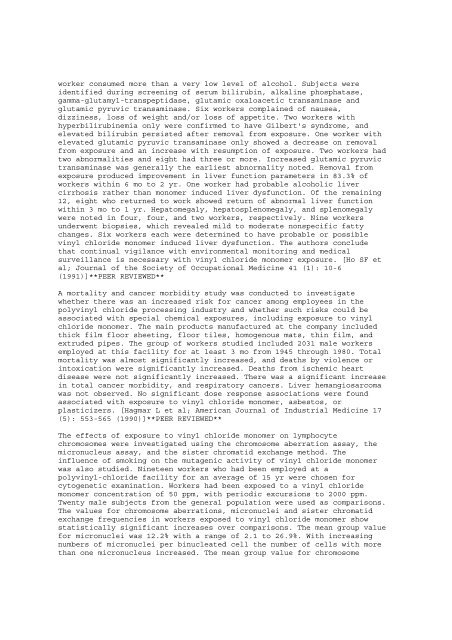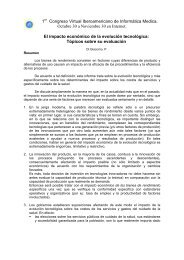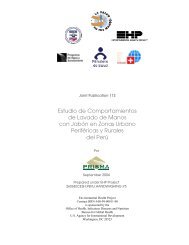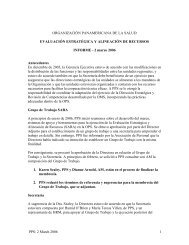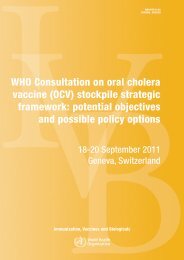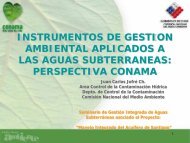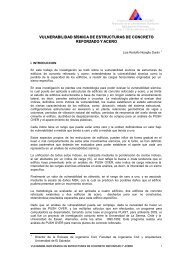espectively. The list <strong>of</strong> longest held jobs for <strong>the</strong> afflicted individualsincluded PVC loader, dryer operator, and maintenance worker for primaryliver cancer-A and primary liver cancer-non-A. It was concluded that vinylchloride may have a broader carcinogenicity spectrum on <strong>the</strong> liver thanknown before and that exposure lower than that occurring in autoclavecleaning can cause primary liver cancers. [Pirastu R et al; AmericanJournal <strong>of</strong> Industrial Medicine 17 (2): 155-61 (1990)]**PEER REVIEWED**Cytogenetic analysis <strong>of</strong> peripheral blood lymphocytes was used to examine43 workers, average age 34.4 years, having an average <strong>of</strong> 11.2 yr exposureto vinyl chloride monomer and 22 referent subjects, average age 40.3 yr,not exposed to vinyl chloride monomer or o<strong>the</strong>r known mutagenic agents. Atleast 100 metaphases with 46 centromeres were analyzed per person for <strong>the</strong>presence <strong>of</strong> chromosomal aberrations, specifically, chromatid breaks,chromosome breaks, chromatid exchanges, and gaps. All aberration typeswere increased in <strong>the</strong> exposed group as compared to <strong>the</strong> referent group,with <strong>the</strong> differences highly significant for chromatid breaks, percentage<strong>of</strong> aberrant cells, and breaks per cell. In both groups <strong>of</strong> subjects, <strong>the</strong>rewas no difference between smokers and nonsmokers in respect to percentage<strong>of</strong> aberrant cells; however, <strong>the</strong>re was a highly significant difference inthis percentage between nonsmokers in <strong>the</strong> two groups, as well as asignificant difference between smokers in <strong>the</strong> two groups. It was concludedthat <strong>the</strong> main reason for <strong>the</strong> increased aberration frequencies is <strong>the</strong>exposure to vinyl chloride monomer. [Hrivnak L et al; Mutation Research240 (2) 83-85 (1990)]**PEER REVIEWED**A group <strong>of</strong> 67 workers occupationally exposed for an average <strong>of</strong> 15 years tovinyl chloride monomer were examined for <strong>the</strong> presence <strong>of</strong> chromosomeaberrations and <strong>the</strong>ir distribution along <strong>the</strong> chromosomal length. Theprocedure made use <strong>of</strong> lymphocyte cultures from blood samples. Measurements<strong>of</strong> 2000 cells per person were scored for chromatid and bichromatidchromosomal breaks. The estimation <strong>of</strong> <strong>the</strong> number and locations <strong>of</strong> breaksinvolved <strong>the</strong> division <strong>of</strong> each chromosome into five and six segments. Atotal <strong>of</strong> 626 breaks were counted in chromosomes A1, A2, and A3, andchromosome group-B, group-C, and group-D. The distribution <strong>of</strong> breaks along<strong>the</strong> chromosome arms <strong>of</strong> <strong>the</strong> lymphocytes <strong>of</strong> <strong>the</strong> vinyl chloride monomerexposed workers was not identical to <strong>the</strong> expected random distribution <strong>of</strong>breaks in <strong>the</strong> lymphocytes <strong>of</strong> an unexposed normal population. Astatistically larger number <strong>of</strong> breaks compared with that expected wasobserved on <strong>the</strong> first and second segment <strong>of</strong> chromosome A1, <strong>the</strong> fifth andsixth segment <strong>of</strong> chromosome A2, and <strong>the</strong> third, fourth, and fifth segment<strong>of</strong> chromosomes in group-B and group-C. However, a statistically smallernumber <strong>of</strong> breaks was observed on <strong>the</strong> first segment <strong>of</strong> chromosome A2, <strong>the</strong>first and third segment <strong>of</strong> chromosome A3, <strong>the</strong> first and second segment <strong>of</strong>chromosomes from group-B and group-C, and <strong>the</strong> first and fourth segment <strong>of</strong>chromosome from group-D. The results indicated <strong>the</strong> existence <strong>of</strong> chromosomelocations highly sensitive and highly resistant to <strong>the</strong> actions <strong>of</strong> vinylchloride monomer. [Fucic A et al; Mutation Research 243 (2) 95-9(1990)]**PEER REVIEWED**An investigation was made <strong>of</strong> 13 workers at a vinyl chloride monomerpolymerization facility in Singapore, who showed persistent abnormalitiesin liver function tests. All subjects were males aged 19 to 55 years attime <strong>of</strong> first exposure. All began employment between 1971 and 1982, whenenvironmental monomer levels ranged from 1 to 21 ppm. After 1983,environmental levels were controlled to a geometric mean <strong>of</strong> 1.5ppm.Exposure duration was 1 to 13 years, with a mean <strong>of</strong> 5.1 years. Only one
worker consumed more than a very low level <strong>of</strong> alcohol. Subjects wereidentified during screening <strong>of</strong> serum bilirubin, alkaline phosphatase,gamma-glutamyl-transpeptidase, glutamic oxaloacetic transaminase andglutamic pyruvic transaminase. Six workers complained <strong>of</strong> nausea,dizziness, loss <strong>of</strong> weight and/or loss <strong>of</strong> appetite. Two workers withhyperbilirubinemia only were confirmed to have Gilbert's syndrome, andelevated bilirubin persisted after removal from exposure. One worker wi<strong>the</strong>levated glutamic pyruvic transaminase only showed a decrease on removalfrom exposure and an increase with resumption <strong>of</strong> exposure. Two workers hadtwo abnormalities and eight had three or more. Increased glutamic pyruvictransaminase was generally <strong>the</strong> earliest abnormality noted. Removal fromexposure produced improvement in liver function parameters in 83.3% <strong>of</strong>workers within 6 mo to 2 yr. One worker had probable alcoholic livercirrhosis ra<strong>the</strong>r than monomer induced liver dysfunction. Of <strong>the</strong> remaining12, eight who returned to work showed return <strong>of</strong> abnormal liver functionwithin 3 mo to 1 yr. Hepatomegaly, hepatosplenomegaly, and splenomegalywere noted in four, four, and two workers, respectively. Nine workersunderwent biopsies, which revealed mild to moderate nonspecific fattychanges. Six workers each were determined to have probable or possiblevinyl chloride monomer induced liver dysfunction. The authors concludethat continual vigilance with environmental monitoring and medicalsurveillance is necessary with vinyl chloride monomer exposure. [Ho SF etal; Journal <strong>of</strong> <strong>the</strong> Society <strong>of</strong> Occupational Medicine 41 (1): 10-6(1991)]**PEER REVIEWED**A mortality and cancer morbidity study was conducted to investigatewhe<strong>the</strong>r <strong>the</strong>re was an increased risk for cancer among employees in <strong>the</strong>polyvinyl chloride processing industry and whe<strong>the</strong>r such risks could beassociated with special chemical exposures, including exposure to vinylchloride monomer. The main products manufactured at <strong>the</strong> company includedthick film floor sheeting, floor tiles, homogenous mats, thin film, andextruded pipes. The group <strong>of</strong> workers studied included 2031 male workersemployed at this facility for at least 3 mo from 1945 through 1980. Totalmortality was almost significantly increased, and deaths by violence orintoxication were significantly increased. Deaths from ischemic heartdisease were not significantly increased. There was a significant increasein total cancer morbidity, and respiratory cancers. Liver hemangiosarcomawas not observed. No significant dose response associations were foundassociated with exposure to vinyl chloride monomer, asbestos, orplasticizers. [Hagmar L et al; American Journal <strong>of</strong> Industrial Medicine 17(5): 553-565 (1990)]**PEER REVIEWED**The effects <strong>of</strong> exposure to vinyl chloride monomer on lymphocytechromosomes were investigated using <strong>the</strong> chromosome aberration assay, <strong>the</strong>micronucleus assay, and <strong>the</strong> sister chromatid exchange method. Theinfluence <strong>of</strong> smoking on <strong>the</strong> mutagenic activity <strong>of</strong> vinyl chloride monomerwas also studied. Nineteen workers who had been employed at apolyvinyl-chloride facility for an average <strong>of</strong> 15 yr were chosen forcytogenetic examination. Workers had been exposed to a vinyl chloridemonomer concentration <strong>of</strong> 50 ppm, with periodic excursions to 2000 ppm.Twenty male subjects from <strong>the</strong> general population were used as comparisons.The values for chromosome aberrations, micronuclei and sister chromatidexchange frequencies in workers exposed to vinyl chloride monomer showstatistically significant increases over comparisons. The mean group valuefor micronuclei was 12.2% with a range <strong>of</strong> 2.1 to 26.9%. With increasingnumbers <strong>of</strong> micronuclei per binucleated cell <strong>the</strong> number <strong>of</strong> cells with morethan one micronucleus increased. The mean group value for chromosome


